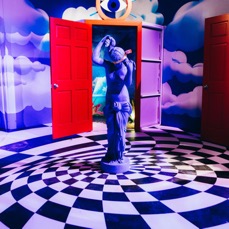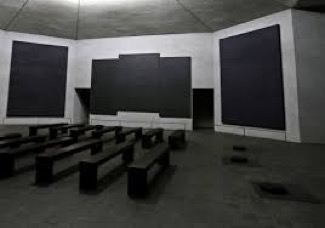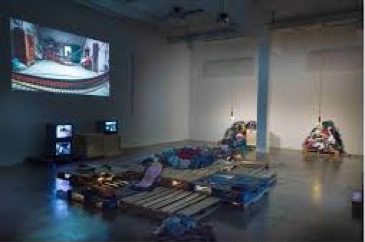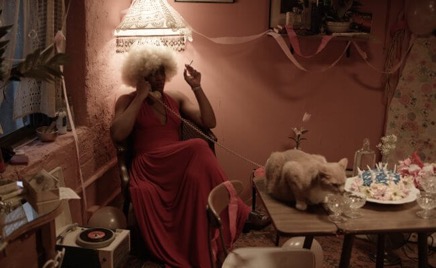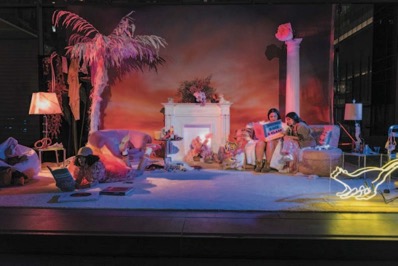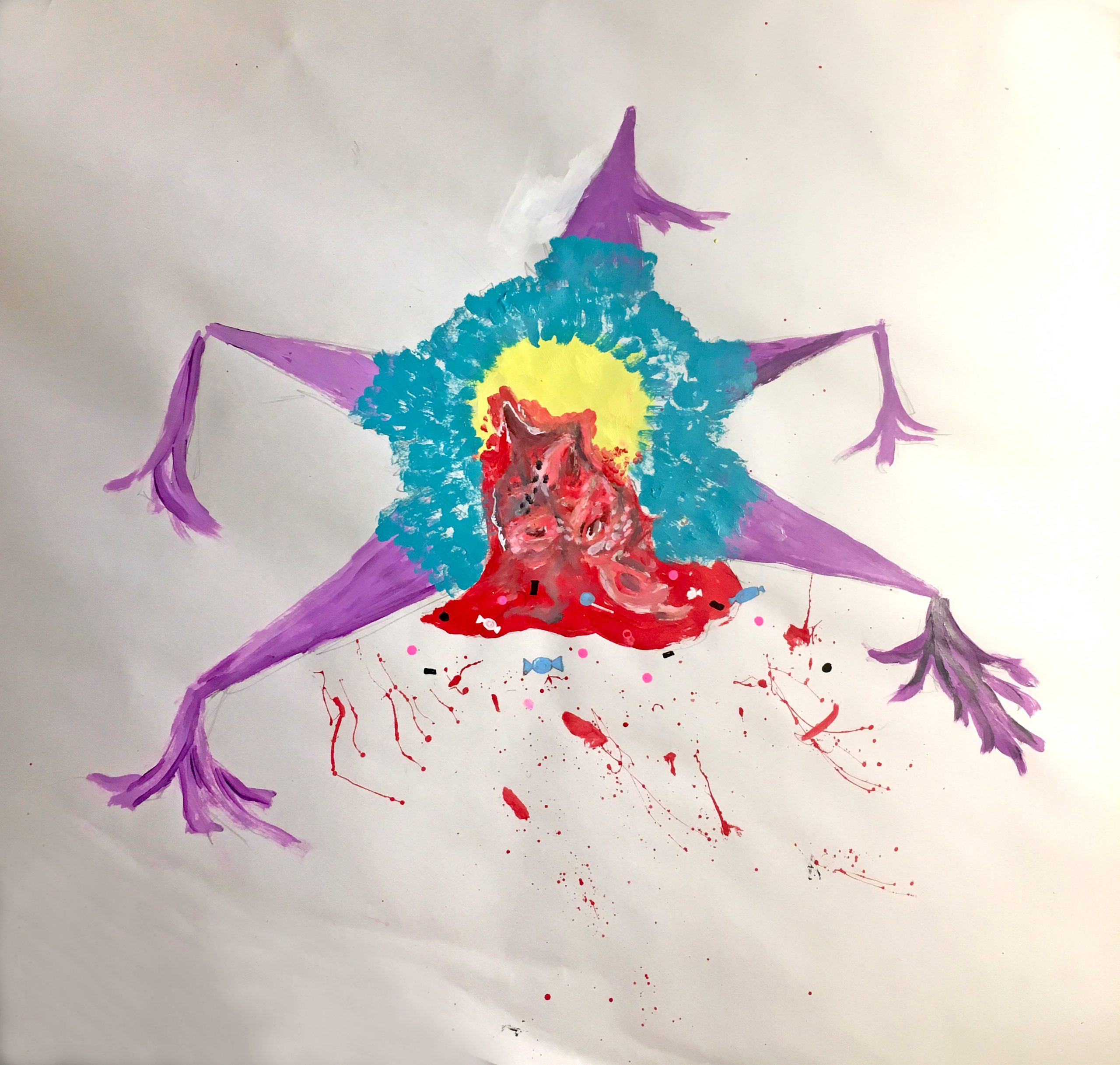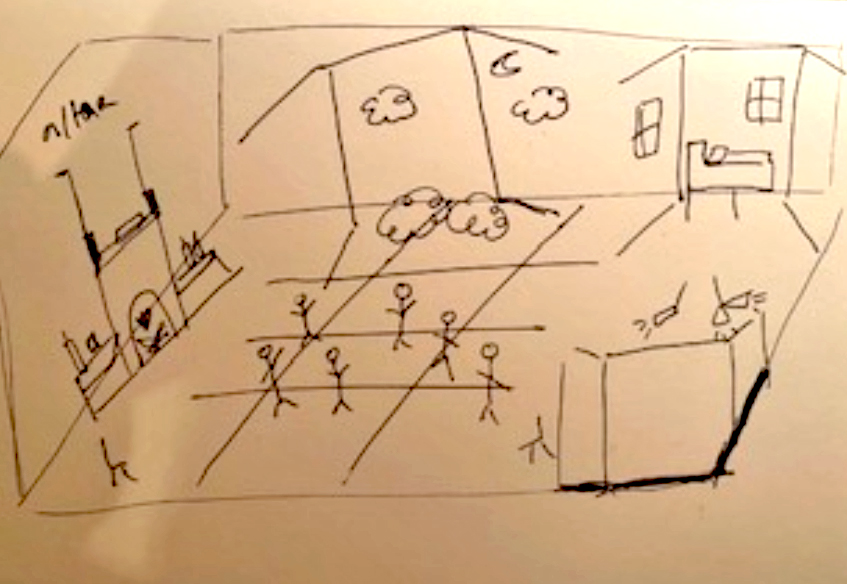
Alexis Aguilar
Statement of Intention:
I want to make this work as a way to create radical intimate space in real time. This will border performance art and installation. I want to create an altar that is devoted for the moment that is being created. I believe films and other types of art have spoken to this notion but I would like to extend this by creating a space for the public as a way that centers the present moment. I want this space to be of a re-piecing of the past and a connection to the future for poc queer communities by strongly placing an anchor in present time, which will be achieved through dancing and meeting in person in one space. As queer people we have a collective history through queer ancestors that came before us, I think it is important to honor them but to also extend our frame of thinking and imaginations to the intimate spaces they got to share in person but perhaps were never recorded or archived. In this way this piece is performative because it is an intentional and curated act of resistance in a public space.
The Look:
I imagine that there will be areas that are large scale installations that imagine personal spaces of real figures for queer communities of color. For example, the film Happy Birthday Marsha! features an imagined conversation that she and Sylvia Rivera could have had about her birthday party, this conversation takes place in Marsha P. Johnson’s cozy pink warmly lit living room that contains trinkets and outfits and other personal items. She’s depicted lovingly twirling the phone cord as she talks to Rivera. The scene plays with femme aesthetic and lighting in a cohesive manner to encourage a feeling of nostalgia and intimacy for a time and place that is non-existent. This scene is an example of reimagined intimate space of queerness. My piece will extend upon this notion by making a scene or several scenes like this in real time and space for the public to engage in. This may present itself as bedrooms or kitchens, or outdoor dreamlike scenarios. The spaces will have elements that are dramatized that create a surreal feeling through elements like lighting.
quote from Trap Door:
“Happy Birthday Marsha!’s heightened moods of glamour make us feel the impossible as something present, tender, and viable, bringing abolitionist desires for alternatives to imprisonment and debt one step closer, by way of what Bassichis, Lee, and Spade have called ‘the nourishing possibilities dreamed of and practiced by our ancestors and friends’ ” (Jeannine Tang, 383)
Though, the installations will be a a focal point visually the atmosphere will remain interactive so people feel encourage to engage the installations, dance and offer something for the alter. I contend that by making these reimagined intimate spaces available to experience in real time (not through film or painting) in an immersive way further makes available the “nourishing” affects that can be had on an individual and community when participating. An example may be of a recreated room or dance studio of choreographer and activist Alvin Ailey.
The altar:
The altar is an important piece because it will function to unify culturally and encapsulate elements of the event that are produced from being together that cannot be expressed through the installations. The actual altar will be taken apart at the end of the night and the installations will be up for view online. Participants are encouraged to put anything of significance to them. Additionally, items that are not measurable will be offered to the public altar. This includes:
Words
Light
Movement
Voice
Perspective
Connection
Missed Connections
Body heat
Pain
color
Ache
Closeness
Displacement
in the body
dreaming (day/night)
Pleasure
Aims and objectives
The project is an act of resistance but also a way to transcend the frame work of resistance itself or the state of resisting. A way to praise existence and heal each other in the moment and commemorate what is currently being created. The objective is to make a “social sculpture” (term coined by Kimberly Drew) that centers queer temporality, existence, and existence despite having to resist.
Quotes from Cruising Utopia : The then and there of Queer Futurity
“So much can be located in gesture. Gesture, I argue throughout this book, signals a refusal to finitude. Dance is an especially valuable site for rumminations on queerness and gesture” (Munoz, 65)
“Queer Dance is hard to catch, and it is meant to be hard to catch - it is supposed to slip through the fingers of those who would use knowledge against us. But it matters and takes on a fast material weight for those of us who perform or draw important sustenance from performance. Rather than dematerialize, dance rematerializes” (Munoz, 81)
These passages highlight dance as a form of performance and resistance. It also examines dance as a way to relocate oneself from a dominate narrative and timeline.
How will the project connect to the site (and its history) where it is installed?
I imagine that the project will take place in a city (Houston most likely) or somewhere else that has land that has brown and black histories attached to it. It will not be site specific because part of the projects’s purpose is to repurpose a space that reinforces a non-linearity of time and movement. Though we will be cognizant of what history the physical land holds, participants will should be more concerned about creating a time and space that is parallel to the dominant history the site contains.
How will this project enrich the lives of the people where it is located?
I think those that engage the space will feel a sense of healing and belonging that are inherent to a realm and history that is not a part of the physical location and those that engage the site can envision a future and a collective past better. Those that engage the project online will have accessibility to the remnants of these (re)imagined intimate spaces and will encourage people to expand their idea of what resistance can look like.
I want to make this work as a way to create radical intimate space in real time. This will border performance art and installation. I want to create an altar that is devoted for the moment that is being created. I believe films and other types of art have spoken to this notion but I would like to extend this by creating a space for the public as a way that centers the present moment. I want this space to be of a re-piecing of the past and a connection to the future for poc queer communities by strongly placing an anchor in present time, which will be achieved through dancing and meeting in person in one space. As queer people we have a collective history through queer ancestors that came before us, I think it is important to honor them but to also extend our frame of thinking and imaginations to the intimate spaces they got to share in person but perhaps were never recorded or archived. In this way this piece is performative because it is an intentional and curated act of resistance in a public space.
The Look:
I imagine that there will be areas that are large scale installations that imagine personal spaces of real figures for queer communities of color. For example, the film Happy Birthday Marsha! features an imagined conversation that she and Sylvia Rivera could have had about her birthday party, this conversation takes place in Marsha P. Johnson’s cozy pink warmly lit living room that contains trinkets and outfits and other personal items. She’s depicted lovingly twirling the phone cord as she talks to Rivera. The scene plays with femme aesthetic and lighting in a cohesive manner to encourage a feeling of nostalgia and intimacy for a time and place that is non-existent. This scene is an example of reimagined intimate space of queerness. My piece will extend upon this notion by making a scene or several scenes like this in real time and space for the public to engage in. This may present itself as bedrooms or kitchens, or outdoor dreamlike scenarios. The spaces will have elements that are dramatized that create a surreal feeling through elements like lighting.
quote from Trap Door:
“Happy Birthday Marsha!’s heightened moods of glamour make us feel the impossible as something present, tender, and viable, bringing abolitionist desires for alternatives to imprisonment and debt one step closer, by way of what Bassichis, Lee, and Spade have called ‘the nourishing possibilities dreamed of and practiced by our ancestors and friends’ ” (Jeannine Tang, 383)
Though, the installations will be a a focal point visually the atmosphere will remain interactive so people feel encourage to engage the installations, dance and offer something for the alter. I contend that by making these reimagined intimate spaces available to experience in real time (not through film or painting) in an immersive way further makes available the “nourishing” affects that can be had on an individual and community when participating. An example may be of a recreated room or dance studio of choreographer and activist Alvin Ailey.
The altar:
The altar is an important piece because it will function to unify culturally and encapsulate elements of the event that are produced from being together that cannot be expressed through the installations. The actual altar will be taken apart at the end of the night and the installations will be up for view online. Participants are encouraged to put anything of significance to them. Additionally, items that are not measurable will be offered to the public altar. This includes:
Words
Light
Movement
Voice
Perspective
Connection
Missed Connections
Body heat
Pain
color
Ache
Closeness
Displacement
in the body
dreaming (day/night)
Pleasure
Aims and objectives
The project is an act of resistance but also a way to transcend the frame work of resistance itself or the state of resisting. A way to praise existence and heal each other in the moment and commemorate what is currently being created. The objective is to make a “social sculpture” (term coined by Kimberly Drew) that centers queer temporality, existence, and existence despite having to resist.
Quotes from Cruising Utopia : The then and there of Queer Futurity
“So much can be located in gesture. Gesture, I argue throughout this book, signals a refusal to finitude. Dance is an especially valuable site for rumminations on queerness and gesture” (Munoz, 65)
“Queer Dance is hard to catch, and it is meant to be hard to catch - it is supposed to slip through the fingers of those who would use knowledge against us. But it matters and takes on a fast material weight for those of us who perform or draw important sustenance from performance. Rather than dematerialize, dance rematerializes” (Munoz, 81)
These passages highlight dance as a form of performance and resistance. It also examines dance as a way to relocate oneself from a dominate narrative and timeline.
How will the project connect to the site (and its history) where it is installed?
I imagine that the project will take place in a city (Houston most likely) or somewhere else that has land that has brown and black histories attached to it. It will not be site specific because part of the projects’s purpose is to repurpose a space that reinforces a non-linearity of time and movement. Though we will be cognizant of what history the physical land holds, participants will should be more concerned about creating a time and space that is parallel to the dominant history the site contains.
How will this project enrich the lives of the people where it is located?
I think those that engage the space will feel a sense of healing and belonging that are inherent to a realm and history that is not a part of the physical location and those that engage the site can envision a future and a collective past better. Those that engage the project online will have accessibility to the remnants of these (re)imagined intimate spaces and will encourage people to expand their idea of what resistance can look like.
Likes (0)
Share


